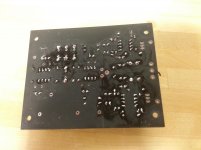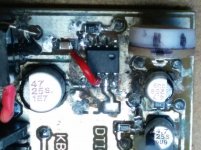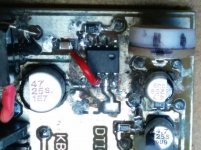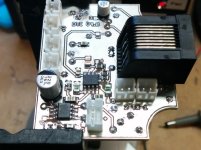I am looking for recommendations for cleaning these boards. I'v tried "Lectro-motive parts cleaner from CRC, rubbing alcohol and water. None of which really cleaned them. I didn't run them under water or soak them in alcohol just tried to wipe the areas with cloth soaked in each. The spray cleaner I sprayed heavily until it dripped off but to no avail. I hesitate to try anything harsher without further guidance. Any suggestions?
Thanks
Thanks
Attachments
The cleaners do not work just by themselves - it requires mechanical action as well. Spray the solvent then use a toothbrush or similar to scrub away the residue.
I use microcare vericlean flux remover at work, its great on all kinds of dirt/flux/oil etc. Highly recommended. And as SyBorg said you need some mechanical action as well, i use a TriggerGrip.
Here is some links
MicroCare MCC-PRO | Flux Removers
MicroCare MCC-ESD | Aerosol Accessories
Here is some links
MicroCare MCC-PRO | Flux Removers
MicroCare MCC-ESD | Aerosol Accessories
It looks a little like a coating has been applied. See how you get on with some acetone and a scrub.
Could be humidity in the air condensing as the cleaner evaporates. Try rinsing again with your cleaner and use a hot air gun or a blow drier to dry the board faster.
Isopropyl rubbing alcohol in 70% solution (very cheap from your local pharmacy) and a tooth brush (not your partners, he/she wouldn't understand). Put some in a cap, dip the brush in it and scrub away at the board, don't be shy. The alcohol will dissolve any flux residue (assuming that's what you want to clean off). Rinse the board gently under tap water if you have a lot of gunk and re-apply clean alcohol to get the water out.
Dry the board. I often use a can of 'duster' air to get out the stuff in tight spots like under chips and such. It's clean and oil free.
I clean regularly when populating a board (unless its an air solder job then I do it all at the end). If you have corrosion already on the board this will help but the damage is pretty much done at that point. Below is an example of a board that didn't get cleaned properly after populating.
Not the best focus on it but the mess is plain. The corrosion was so bad it shorted out a power trace under the chip that nearly burnt through the entire laminate (on a 9V battery). The red wire is a patch job until another PCB could be made.
Dry the board. I often use a can of 'duster' air to get out the stuff in tight spots like under chips and such. It's clean and oil free.
I clean regularly when populating a board (unless its an air solder job then I do it all at the end). If you have corrosion already on the board this will help but the damage is pretty much done at that point. Below is an example of a board that didn't get cleaned properly after populating.
Not the best focus on it but the mess is plain. The corrosion was so bad it shorted out a power trace under the chip that nearly burnt through the entire laminate (on a 9V battery). The red wire is a patch job until another PCB could be made.
Attachments
Last edited:
I've uploaded another pic to show the difference. A similar board right after soldering. Nice and clean using a toothbrush and rubbing alcohol.
http://www.diyaudio.com/forums/attachment.php?attachmentid=460518
http://www.diyaudio.com/forums/atta...=460519&stc=1&d=1421791077&stc=1&d=1421791077
http://www.diyaudio.com/forums/attachment.php?attachmentid=460518
http://www.diyaudio.com/forums/atta...=460519&stc=1&d=1421791077&stc=1&d=1421791077
Attachments
I get the 99% isopropanol; doesn't leave as much moisture behind. Some pharmacies keep the 99% behind the counter.
I've tried denatured alcohol with some success, and less lingering odor to offend my other half's very sensitive nose. Acetone evaporates >fast< and can attack some plastics and solder masks. Some brush action may be required and a generous supply of cotton swabs. A compressed air source to blast out trapped solvent is good.
At one time I used a lacquer thinner from Sears, but what I'm finding now doesn't seem to work as well. Wonder what changed? At any rate, Dawn's nose alarm goes off when I try to use the stuff, so I've switched to corrupted ethanol. The 99% isopropanol sounds like another good choice, I will have to try some.
--Damon
At one time I used a lacquer thinner from Sears, but what I'm finding now doesn't seem to work as well. Wonder what changed? At any rate, Dawn's nose alarm goes off when I try to use the stuff, so I've switched to corrupted ethanol. The 99% isopropanol sounds like another good choice, I will have to try some.
--Damon
ketones, like acetone, MEK and nitro methane will eat some plastics often found in electronics
and carbon doesn't dissolve in anything that the board would survive
and carbon doesn't dissolve in anything that the board would survive
Denatured alcohol and a nylon brush ended up working fine. A couplesof spots needed a second scrubbing.
99% isopropanol is one of the better ones as it doesn't leave a white debri on the PCB. Hard to get here except if you know the way to find it.
I second the 99% Rubbing alcohol. The higher the percentage the better. I just thought it was all the same until i bought another bottle and it was worthless. Turned out to be 60% or something. I use a stiff brush and after scrubbing, i blow it off sideways, like a plate draining. Then i can work on it. Good luck!
Loads of IPA Alcohol, a toothbrush, those cotton bud on a stick things and compressed air from a can. Works well enough for me.
- Status
- Not open for further replies.
- Home
- Design & Build
- Construction Tips
- Cleaning Circuit Boards



